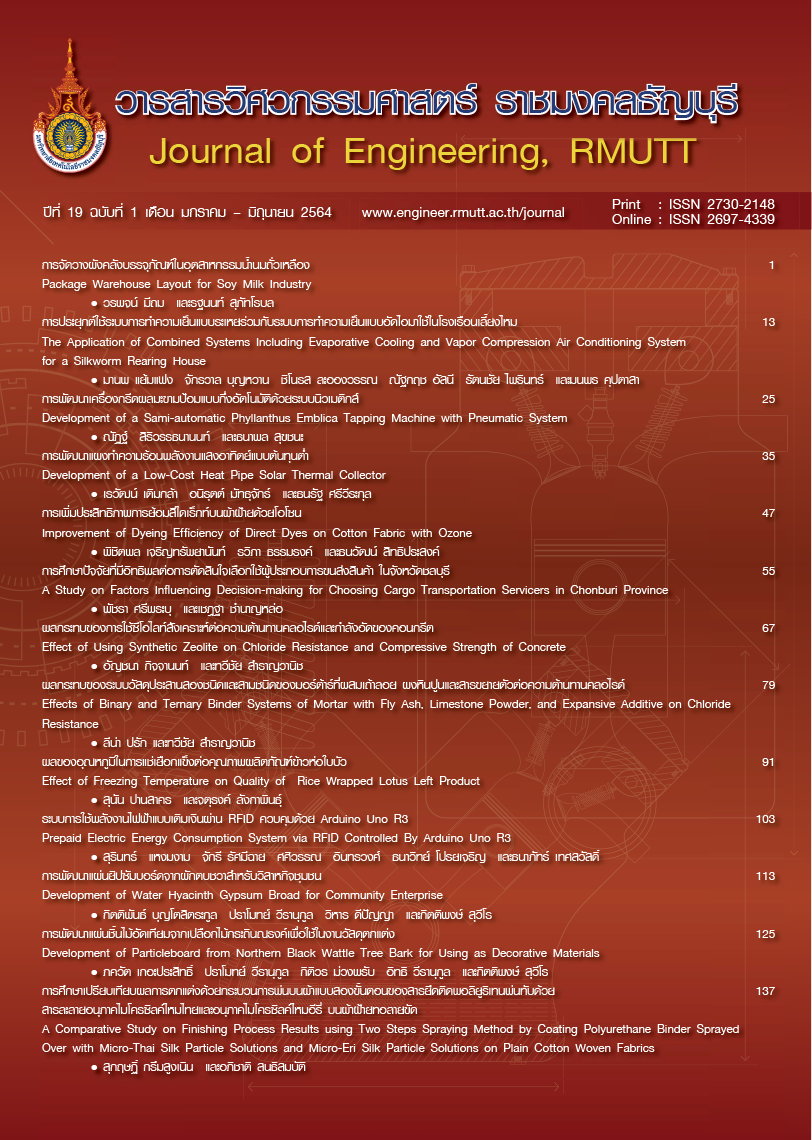A Comparative Study on Finishing Process Results using Two Steps Spraying Method by Coating Polyurethane Binder Sprayed Over with Micro-Thai Silk Particle Solutions and Micro-Eri Silk Particle Solutions on Plain Cotton Woven Fabrics
Main Article Content
Abstract
The objective of this research was to compare the results of finishing processes applied by the two-steps spraying method. The step was spraying fabrics with polyurethane binder and then spray over with solutions of micro-Thai and micro-Eri silk particles (the smallest single particle of 2,250 x 2,320 and 1,080 x 2,140 nm respectively) on plain cotton woven fabrics. The fabrics were tested with rubbing fastness testing in dry and wet conditions, washing fastness testing, wicking testing, and anti-bacterial testing of textiles. The fabric coated with the binder and sprayed with 10% micro-Thai silk particles solutions was found to have the highest water absorption followed by fabric coated with the binder and sprayed with 10% micro-Eri silk particle solutions. As for antibacterial testing, fabric coated with the binder and sprayed with 8% of micro-Thai silk solutions could resist gram-negative (Escherichia coli) bacteria and gram-positive (Staphylococcus aureus) bacteria. On the other hand, fabric coated with the binder and sprayed with 6% of micro-Eri silk particles solutions could resist gram-negative bacteria and the fabric coated with the binder and sprayed with 4%, 8% and 10% micro-Eri silk particle solutions were resistant to gram-positive bacteria. It could be concluded that the fabric coated with the binder and sprayed with 8% of micro-Thai silk particle solutions was resistant to gram-positive and gram-negative bacteria. In conclusion, the results of the above formula are suitable for finishing on the cotton woven fabrics or other antibacterial required fabrics such as fabrics for furniture, bedding, curtains, etc.
Article Details
The manuscript, information, content, picture and so forth which were published on Frontiers in engineering innovation research has been a copyright of this journal only. There is not allow anyone or any organize to duplicate all content or some document for unethical publication.
References
The support arts and crafts international centre of Thailand. [Internet].[cited 2020 Jan 25]: [13].Availability From:https://www.sacict.or.th/uploads/items/attachments/956936879f66f5cf4ffbf3aefffd56ca/_d9c828d53e9a176bb883c0ee1d35378a.pdf
Photchanaprasert N. Guidelines to promote the industrial potential of Eri farmers: Final research report. Bangkok (Thailand): Thailand Research Fund, Bangkok (Thailand); 2018:190-204.
Sonthisombat A, Speakman P. Silk: Queen of Fibres-The Concise Story. Journal of Engineering, RMUTT. 2003;2(4):84-97.
Sonthisombat, A. 1993, M.Sc.Dissertation, The University of Leeds, UK.
Sonthisombat, A. 1997, Ph.D.Thesis, The University of Leeds, UK.
Sonthisombut A, Sungnoo, S, Sakulkhemruthai S, Asawasupharuk P, Phromhitathorn C. A Production of sericin and fibroin nanoparticles for finishing on sportswear. funded by the Thailand Textile Institute. Rajamangala University of Technology, Thanyaburi, Pathum Thani. 2007:1-278.
Khum Si Wai P, Trakulphua Y. 6th National Hatyai Academic Conference Hat Yai University. 2015:1524-34.
Robson R.M., Lewin M, Pearce E.M., Marcel Dekker Inc. Silk Compositio, Structure and Properties in Handbook of Fiber Science and Technology. New York. 1985:647-700.
Sonthisombat A. Silk (Fibroin and Sericin) powder production process for applications in textile, medical and cosmetic, Thailand Petty Patent No. 9418. Jan. 6, 2015
Nuengchomphu N, Sungnoo S, Sonthisombat A. A Finishing Process of a Mixture of Polyurethane Binder and Micro/Nano Silk Particles Coated on Plain 100% Cotton Woven Fabrics Using One and Two Steps Spraying Method. Journal of Engineering, RMUTT. 2019;15(2):7-18.
Sonthisombat A. Textile Chemical Processing, Faculty of Engineering, Rajamangala Institute of Technology, Pathumtani, 2002: 1-327.
Pontuk S, Thongban N, Chaipreecha J. A finishing chitosan extracted from shrimp farmers prizes by coating polyester 100% with anti-bacterial properties. The bachelor’s degree of Engineering Project Department of Textile Engineering, Rajamangala University of Technology Thanyaburi. 2015;1(1):14-23
Spray Gun. [Internet]. [Cited 2020 Fab 19]. Available From:http:// anestiwata.com /wp-content/uploads/2011/12/ manual-catalog.pdf
Painting technique [Internet]. [Cited 2020 Mar 13]. Available From: https://goo.gl/uSWrfv
SemAfore 5.2 [Internet]. [Cited 2020 Mar 29]. Available From:http://semafore. software. informer.com/5.2/


